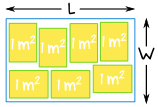Solving Inequality Word Questions
(You might like to read Introduction to Inequalities and Solving Inequalities first.)
In Algebra we have "inequality" questions like:

Sam and Alex play in the same soccer team.
Last Saturday Alex scored 3 more goals than Sam, but together they scored less than 9 goals.
What are the possible number of goals Alex scored?
How do we solve them?
The trick is to break the solution into two parts:
Turn the English into Algebra.
Then use Algebra to solve.
Turning English into Algebra
To turn the English into Algebra it helps to:
- Read the whole thing first
- Do a sketch if needed
- Assign letters for the values
- Find or work out formulas
We should also write down what is actually being asked for, so we know where we are going and when we have arrived!
The best way to learn this is by example, so let's try our first example:

Sam and Alex play in the same soccer team.
Last Saturday Alex scored 3 more goals than Sam, but together they scored less than 9 goals.
What are the possible number of goals Alex scored?
Assign Letters:
- the number of goals Alex scored: A
- the number of goals Sam scored: S
We know that Alex scored 3 more goals than Sam did, so: A = S + 3
And we know that together they scored less than 9 goals: S + A < 9
We are being asked for how many goals Alex might have scored: A
Solve:
Sam scored less than 3 goals, which means that Sam could have scored 0, 1 or 2 goals.
Alex scored 3 more goals than Sam did, so Alex could have scored 3, 4, or 5 goals.
Check:
- When S = 0, then A = 3 and S + A = 3, and 3 < 9 is correct
- When S = 1, then A = 4 and S + A = 5, and 5 < 9 is correct
- When S = 2, then A = 5 and S + A = 7, and 7 < 9 is correct
- (But when S = 3, then A = 6 and S + A = 9, and 9 < 9 is incorrect)
Lots More Examples!

Example: Of 8 pups, there are more girls than boys.
How many girl pups could there be?
Assign Letters:
- the number of girls: g
- the number of boys: b
We know that there are 8 pups, so: g + b = 8, which can be rearranged to
We also know there are more girls than boys, so:
We are being asked for the number of girl pups: g
Solve:
So there could be 5, 6, 7 or 8 girl pups.
Could there be 8 girl pups? Then there would be no boys at all, and the question isn't clear on that point (sometimes questions are like that).
Check
- When g = 8, then b = 0 and g > b is correct (but is b = 0 allowed?)
- When g = 7, then b = 1 and g > b is correct
- When g = 6, then b = 2 and g > b is correct
- When g = 5, then b = 3 and g > b is correct
- (But if g = 4, then b = 4 and g > b is incorrect)
A speedy example:

Example: Joe enters a race where he has to cycle and run.
He cycles a distance of 25 km, and then runs for 20 km. His average running speed is half of his average cycling speed.
Joe completes the race in less than 2½ hours, what can we say about his average speeds?
Assign Letters:
- Average running speed: s
- So average cycling speed: 2s
Formulas:
- Speed = DistanceTime
- Which can be rearranged to: Time = DistanceSpeed
We are being asked for his average speeds: s and 2s
The race is divided into two parts:
1. Cycling
- Distance = 25 km
- Average speed = 2s km/h
- So Time = DistanceAverage Speed = 252s hours
2. Running
- Distance = 20 km
- Average speed = s km/h
- So Time = DistanceAverage Speed = 20s hours
Joe completes the race in less than 2½ hours
- The total time < 2½
- 252s + 20s < 2½
Solve:
So his average speed running is greater than 13 km/h and his average speed cycling is greater than 26 km/h
In this example we get to use two inequalities at once:

Example: The velocity v m/s of a ball thrown directly up in the air is given by v = 20 − 10t, where t is the time in seconds.
At what times will the velocity be between 10 m/s and 15 m/s?
Letters:
- velocity in m/s: v
- the time in seconds: t
Formula:
- v = 20 − 10t
We are being asked for the time t when v is between 5 and 15 m/s:
Solve:
number first, so swap over:
So the velocity is between 10 m/s and 15 m/s between 0.5 and 1 second after.
And a reasonably hard example to finish with:
Example: A rectangular room fits at least 7 tables that each have 1 square meter of surface area. The perimeter of the room is 16 m.
What could the width and length of the room be?

Make a sketch: we don't know the size of the tables, only their area, they may fit perfectly or not!
Assign Letters:
- the length of the room: L
- the width of the room: W
The formula for the perimeter is 2(W + L), and we know it is 16 m
- 2(W + L) = 16
- W + L = 8
- L = 8 − W
We also know the area of a rectangle is the width times the length: Area = W × L
And the area must be greater than or equal to 7:
- W × L ≥ 7
We are being asked for the possible values of W and L
Let's solve:
So the width must be between 1 m and 7 m (inclusive) and the length is 8−width.
Check:
- Say W = 1, then L = 8−1 = 7, and A = 1 x 7 = 7 m2 (fits exactly 7 tables)
- Say W = 0.9 (less than 1), then L = 7.1, and A = 0.9 x 7.1 = 6.39 m2 (7 won't fit)
- Say W = 1.1 (just above 1), then L = 6.9, and A = 1.1 x 6.9 = 7.59 m2 (7 fit easily)
- Likewise for W around 7 m